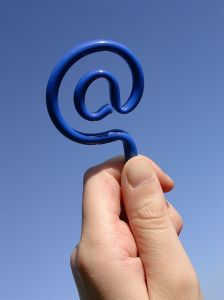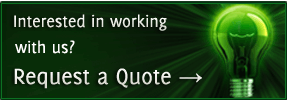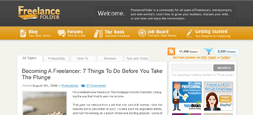The Small Business Guide to Taming Your Email
 When you’re running a small business, email is an indispensable tool that can help you communicate quickly, resolve problems effectively, and generally grow your business. But there’s a dark side to email as well – if you don’t manage it carefully, your inbox can spiral out of control, playing havoc with your productivity and limiting your potential growth.
When you’re running a small business, email is an indispensable tool that can help you communicate quickly, resolve problems effectively, and generally grow your business. But there’s a dark side to email as well – if you don’t manage it carefully, your inbox can spiral out of control, playing havoc with your productivity and limiting your potential growth.
But there’s hope beneath that pile of unread messages. With just a few simple adjustments, your inbox can become a well-oiled machine that keeps you productive and helps you market yourself and your small business.
Let’s take a look at five simple tips that will tame the email tiger, once and for all.
Treat Every Email As An Investment
Remember, when you read your email, you’re spending your most valuable resource on the planet: your personal time. You can’t get that back (and you need it to build your business) so it’s something you want to handle with care.
You can change the entire way you manage your out-of-control inbox by viewing the time you spend in there as time from which you absolutely must get a high return on investment. Just as you track your other marketing efforts and their cost vs. payoff, you should be aware of the return you’re getting from your inbox. Every time you open your email reader, remind yourself that you’re on the clock – and that you expect to get your money’s worth out of every minute.
How To Make This Easier: Set specific times to go through email – and time limits – and stick with them. I find that when I have a set start/stop time, I focus more and run through the inbox buildup faster. Try it – you’ll see the results for yourself.
Separate The Wheat From The Chaff
Just as you’d kill off a marketing campaign that wasn’t paying off, you should wipe out the email that just isn’t doing much for your business. Newsletters you don’t read, notifications that aren’t relevant to you anymore – all these kinds of emails need to stop cluttering your inbox and stealing your attention.
A good rule of thumb is this: if you haven’t read email by a particular sender in 30 days, you probably never will. Lighten your daily email load and leave more time for the messages that really matter.
How to Make This Easier: If the idea of doing a mass unsubscribe makes you squirm, there’s another option: take all the emails you feel like you “might” get to later and set up a filter that routes them to a special “Later” folder, completely bypassing your inbox. I do this, and it helps keep non-critical email from stealing my attention in the present.
Create Filters That Prioritize Email For You
Smart marketers understand the value of targeting specific demographics – the more precise the focus, the better the response.
You don’t try to be all things to all people in one campaign. Your attention span works the same way, so it’s a good idea to create filters that separate email into different categories – emails from clients in one folder, messages from partners in another, relevant newsletters / blog updates in another. This way, you won’t be switching gears as often and you can consciously select your focus for the moment.
How to Make This Easier: Create folders for a few key categories – the ones that require action – and make those filters first. Then make it a habit to add new email addresses to their relevant filter each day (rather than doing it as you receive the email, you may want to set aside 10 minutes at the end of the day to do a global filter update)
Build Templates That Help You Market More Effectively
An ongoing marketing campaign often uses the same elements to help reduce rework and reinforce the company’s brand. Your email can leverage that same concept. As you discover you are answering customer/prospect emails with the same information as time goes on, you can build email templates that have relevant information already included in them – whether it is something informative like a list of frequently asked questions or a short note about a product or service you have available that is related to the email’s topic. Having templates also helps you get you through your inbox more quickly – which gives you more time for marketing efforts.
How to Make This Easier: When you send an email that you think is good template material, flag it or move it to a folder that you reserve for template creation. Then when you have a bit of free time, hit that folder and begin building your templates. A quick Google search on your email program of choice will teach you how to make templates if you don’t already know how.
Treat Every Email As A Chance To Make A New Fan
When it comes down to it, you know word-of-mouth marketing is the best kind of marketing there is, hands down. So it only makes sense that when you have email interactions with customers, prospects or partners, you do all that you can to make the exchange as valuable, personable and memorable as possible. And while you want to crank through your inbox quickly, you need to slow down on these emails and give them the personal care they deserve.
Remember, each communication is a chance to impress and satisfy in a way that gets the recipient talking – and building your brand – and that’s what your marketing efforts are all about.
How to Make This Easier: When you open each email from a customer, prospect or partner, ask yourself what makes you feel welcomed, appreciated and acknowledged in your correspondence with others – and pack those same qualities in before you hit “Send.”
Email is a Powerful Tool – Use It Wisely
When you sit down to tackle your inbox, remember that you’re dealing with more than just email – you’re enjoying an opportunity to put your marketing skills to work, build your business, and really wow your clients with great treatment. Use these tips wisely, and enjoy the rewards of an inbox that’s less cluttered, more focused, and offers you a return that you’ll be happy about.





Reader Comments
You are so right! Nowadays, email is a primary form of communication and if you neglect it, you pass up another opportunity to grow your business.
If you don’t have the proper time to devote to your Inbox, think about working with a Virtual Assistant to handle it for you.
As a VA myself, this is one daily tasks I handle for my clients. I create templates so that I can respond to general inquiries, status updates and pleas for immediate help with ease and efficiency. I’m prompt, professional and polite (I use manners as a way to create a rapport with people in a virtual setting—go figure!).
If you value your client base and you aren’t able to manage your Inbox for yourself, you might consider working with a Virtual Assistant.
Sounds like I missed “Get a VA” as the best tip of them all! Can’t believe I left that one out.
Thanks for commenting, Mia. I just checked out your site - do VAs typically cover the range of services you do (such as networking)?
I’m going to have to strongly disagree with one point in this post:
“Set specific times to go through email”
While this is a great productivity tip for the business owner, it’s one of the worst things you can do to harm your customer service and responsiveness to customers, the very people that keep you in business.
Not answering your email within half an hour is the equivalent of a phone call response like, “We’re sorry… we can’t take your call right now…”
The customer says: Hallo? No one’s home? I can’t get answers? I have to WAIT? Screw this, I’m going somewhere else…
The singlemost pet peeve of mine as a consumer and as a buyer is being made to wait. Some providers answer me within minutes - and I’m happy and do business with them repeatedly. Some use this timed email method, and I wait half a day, sometimes a whole day before getting an answer.
Set up Gmail and Google Apps instead. Use their notifier that gives a snippet glance of an email’s text as it comes in. You can glance without stopping what you’re doing and decide instantly whether the email can wait or needs immediate response.
James,
An interesting point you raise.
I think it’s possible to satisfy the need for a quick response and still have the ability to go through your email in specific blocks. By installing some type of email notifier system that will alert you with new messages, I use MS outlook/exchange/smartphone combo, you can quickly see who the message is from and assess whether it needs a response. That’s step 1 (as you mentioned above).
Step 2 is to set up a basic email response template, something that you can use to notify people that you have received their message and will look it over and respond soon. If you make it nice and friendly, most people will be happy with that for an initial response. You can then write the detailed email at your set block of time.
I’ve used this system for a while now with great results. Customers love the quick email response, and most don’t mind waiting a bit to receive all of the information.
Dave, what do you think of all of this?
@ Mason - Exactly. There are ways around this and plenty of resources to help people provide responsiveness for businesses. The two answers you provided, an auto-responder and a notifier, are the best workarounds.
And if businesses do use the timed check-in method, I think twice a day just isn’t enough, so frequent check-ins would be a better idea.
What’s important is *some* sort of response - even if it’s not a personal one or full of answers.
I think the frequency of check-ins depend on your role in the business.
For solo-preneurs it can be difficult to check in more than twice a day and still maintain schedule with client work and business growth.
On the other hand, the people involved primarily in sales (and I say primarily since in small business everyone is usually involved in everything) should probably check their correspondence much more frequently.
It also depends on your personal workload and typing ability. I know some people who would go out of business if they checked their email more than once a day (of course, they aren’t in online businesses for a reason).
@Dave,
Thanks for checking out my site. I have a brand new site launching mid-June that will list my revised services in greater detail.
Yes, in addition to handling email for my clients, I also provide social networking.
As crazy as it sounds, what started off as an energy-drain has spring-boarded into a full on viral marketing strategy that clients actively seek out.
With the airing of the _60 Minutes_ piece a few months back on Mark Zuckerberg, social networking has become more legitimatized and business owners are stumbling over themselves to see what all the fuss is about.
What they soon discover is that there’s a lot of maintenance that goes into the development of an authentic online presence, one that doesn’t annoy or bother. There’s definitely a finesse to the strategy. One word = restraint.
Not all VAs love email and networking like I do. My slant has really been on stellar email customer service and building an online presence.
Independent VAs, like myself, all specialize in their own thing. As the e-trends grow, so will the support surrounding it.
Thanks for your insights, Dave. Cool name.
m.
http://www.facebook.com/people/Mia_Chambers/578197263
When to check e-mail is a really good discussion…
What most individuals and been business owners alike don’t realize is that when you have your e-mail open pinging and flashing every time a new e-mail is received on the server, it is an interruption. Interruptions are costly. It is widely accepted that the average time that it takes for an average person to recover from the interruption (not handle it) is four minutes.
So, if you look up from a project you are working on only 15 times a day for 15 e-mail interruptions, you have lost an hour in recovery time—4 minutes times 15 interruptions. Many workers are receiving anywhere from 80-150 emails daily.
Most people who send an e-mail do not expect an immediate response. The business needs to consider the cost of immediately responding, because those interruptions are a mounting cost of doing business. It is better to decide the maximum interval your business can afford, and set your email programs to deliver the mail in those intervals, such as every half hour or every hour. Instead of receiving lets say 4 emails at different times within that half hour, with potential to interrupt you 4 times, is you set your email program to set a 30 minute interval, you’ll be interrupted only once.
I am a proponent of checking email 5 times daily, and encouraging people to call when something is needed in under 3 hours. Works for me!
Add Your Comment